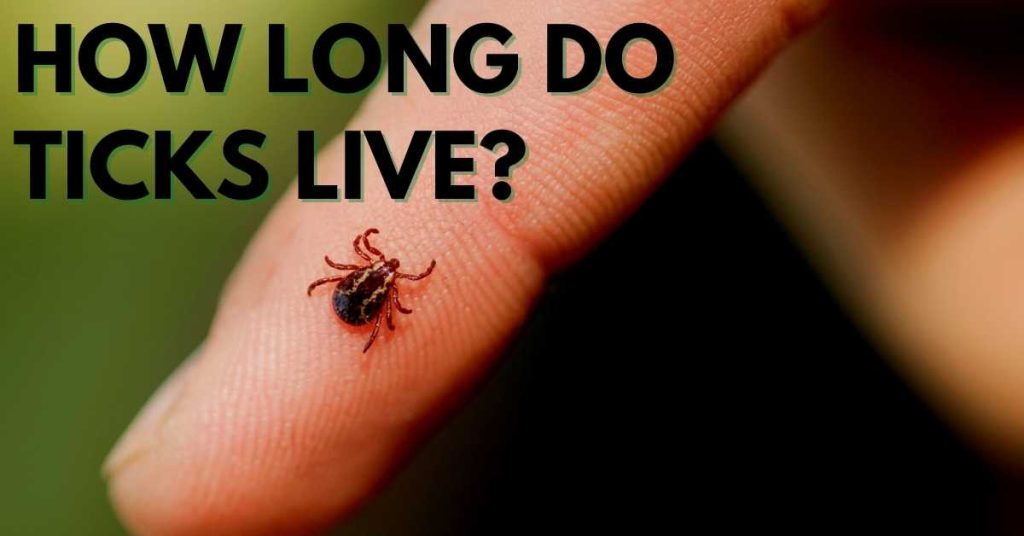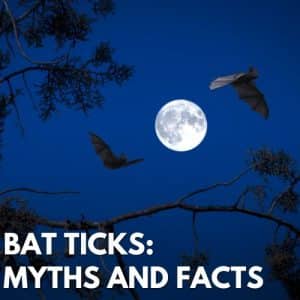
Ticks can live up to a maximum of 3 years and can be active during all seasons – spring, summer, and winter. However it largely depends on the type of tick species and the tick life cycle. There are many myths surrounding ticks, especially about their lifespan. In this article, we can discuss the life cycle of ticks and how long do ticks live without a host.
What Is A Ticks Life Span?
The lifespan of a tick depends on several factors, including the type of tick, its environment, and its host. Ticks’ lifespan can be about two to three years.
Ticks go through four stages of life: egg, larva, nymph, and adult. The timespan of each stage varies depending on the species of tick, but the entire lifespan from egg to adult typically lasts between two and three years. The tick will feast on blood during each stage until it reaches its required weight gain. Once filled, the tick will detach from its host and molt into the next stage of life.
Tick Growth Stages
Ticks go through three distinct growth stages during their lifespan – the larva, nymph, and adult. Each stage lasts for a different timespan depending on the tick species and the temperature. The eggs may hatch after two to three weeks as the temperature warms. The hatching period can extend up to 60 days.
During the larval stage, ticks feed on small animals, such as rodents or birds. They then molt into nymphs, about the size of a poppy seed. Nymphs typically wait for a larger host, such as a deer, before feeding. Once they’ve fed, ticks enter the adult stage. Adults can be twice as large as nymphs and live for up to two years. Both male and female adults must feed on blood before they mate. After mating, females will lay eggs and then die. The tick eggs will hatch into larvae, starting the cycle again.
Ticks can go through this cycle of feeding and molting 2 to 3 times during their lifetime.
Let us know about the tick life cycle in a detailed manner.
Generally, ticks have four life cycle stages. They are
- Embryonated egg
- Larva stage
- Nymph
- Adult stage
Source: Pinterest
Embryonated egg:
- Female ticks seek sheltered environments after mating to lay their eggs.
- Blood meal volume is one of the factors that affects the number of eggs deposited.
- If female ticks consume larger blood meals, they may lay more eggs.
- A Soft tick called Argasidae deposits small egg batches after each blood meal. They are capable of feeding and ovipositing many times.
- In the family of ticks called Ixodidae, the mated females lay more than thousands of eggs in a single gonotrophic cycle.
- The American Dog tick variety lays an average of 5.380 eggs.
- The highest egg mass ever recorded from a single tick was 22.891, (Amblyomma nuttalli female).
Larva:
- Tick egg hatches into larvae (called seed ticks, which only have six legs) later in the summer.
- Once they reach this life stage, they will become ready to wait for their first host to pass by.
- They need a host in each stage of life to pass on to the next.
- In this stage, ticks use smaller mammals as their first host, and the white-footed mouse, an efficient transmitter of Lyme disease, is one of the most common mammals they feed on in this period.
- If larvae find and feed on a mammal with a disease, the tick will get the disease through transmission. They will transmit it to other mammals like raccoons or birds who may not have the infection.
- If the larvae feed on non-infected animals, they will not become infected with Lyme disease at this point in their life.
- They do not carry tick-borne illnesses, but they become carriers of Lyme when they suck the blood of an already infected mammal.
- Larvae growth peeks in August. Larvae fall to the ground after feeding on a host and begin transitioning to their next life stage as nymphs.
Nymphs:
- Nymphs have eight legs and resemble the adult tick.
- They can live without feeding for long periods in this stage until finding a host.
- Soft ticks have many nymphal molts, and this number of nymphal states is not consistent within the same species.
- When a nymph finds a host, it will hang tight and feed on it for around five days.
- If this nymph has a Lyme disease infection from the host during its larva stage, it could infect the new host too.
Adult:
- If the nymph saturates with blood, it will fall off its host and reach the adult life stage.
- The tick will look for its third and final host for feeding in this adult stage.
- They feed on the blood from three different hosts during their entire lifetime.
- Humans become one of their hosts in either the nymph or adult stage.
- Ticks will nest or begin mating based on the time of year and weather conditions.
- Male ticks die after mating with one or two females, and the female ticks will die after reproducing by laying thousands of eggs during the spring.
When Do Ticks Hatch?
Ticks hatch from eggs in the springtime, typically around April or May. However, activity can vary depending on the region and the temperature. In southern states, such as Florida, tick activity begins earlier in the year, while in northern states, hatching may not occur until June or July.
The time it takes for tick eggs to hatch differs from one tick species to another but can range from a few days to several weeks. The eggs are laid in moist environments, such as leaf litter or tall grass, and must be kept moist to survive.
For example, the American Dog Tick eggs take about 26 to 40 days to hatch. The deer or black-legged tick eggs often hatch in the late summer months. The Hyalomma tick eggs hatch over two to four days.
Can Ticks Live Without A Host?
An adult tick can survive without a host for a maximum of 500 to 600 days, but other stages of ticks needs a host to survive. The type of hosts may vary based on the growth stages. For instance, tick larvae and nymph need smaller hosts, whereas the adults will need a large host like wild animals, birds, and mammals including humans, dogs, cats, etc.
How Long Can Ticks Live Without A Host?
How long a tick can live without a host depends on the species of tick, the stage of its lifecycle, and the environmental conditions. Some ticks can survive for months or even years without food, while others will only live for a few days. Ticks need blood to survive, so they usually die within a few days if they cannot find a host.
For example, the deer tick can only live for about 48 hours without a host, while the brown dog tick can live for up to 6 months.
- In the first stage, ticks’ eggs do not need a host to survive.
- When an adult female tick lays eggs, these eggs live without a host until they hatch into larvae.
- After hatching, they need to feed on blood for the rest of their life to survive.
- Ticks in the larval, nymph, and adult stages can live for different time duration without a host.
- American dog ticks, common in North America, feed on dogs, humans, cattle, and other animals and live for around two years without a host.
Most ticks need relatively high humidity levels to survive, so they are often found in areas of dense vegetation. When choosing a camping site or hiking trail, it is important to avoid areas with long grasses or leaf litter, as these provide the ideal habitat for ticks. By being aware of their preferred habitat and taking precautions, you can reduce your risk of encountering these dangerous pests.
While ticks can live without a host for extended periods, they are not immortal. Eventually, ticks will succumb to starvation if they cannot find a meal.
How Long Can A Deer Tick Live Without A Host?
Deer ticks or blacklegged ticks can live for long periods without a host, but their survival depends on several factors. Perhaps the most important factor is temperature. At lower temperatures (i.e., cool, moist environment), most of the tick species can comfortably survive and can endure for months or even years without feeding. In contrast, ticks are more likely to die at higher temperatures, particularly if they become dehydrated.
Deer ticks are more likely to survive in areas with high humidity, as this helps to prevent them from becoming dehydrated. With these determinants in mind, it is clear that deer ticks can survive long periods without a host, but their longevity is highly variable and depends on environmental conditions.
How Long Can A Deer Tick Live Without Blood?
A deer tick can live for quite some time without blood, though its lifespan will be shorter without a consistent food source. Adult deer ticks can survive for up to two years without blood, though they typically only survive for about one year in the wild.
However, if a deer tick does not have access to blood, it will eventually die. It is because ticks need blood to survive; it provides them with essential nutrients and moisture. Without blood, a tick will eventually shrivel up and die. Thus, while a deer tick can technically live without blood for a while, it is not a sustainable lifestyle for the tick.
How Long Do Seed Ticks Live?
Seed ticks are another name for tick larvae. They are quite tiny and are born from the eggs of an adult female tick. As a result, they are rarely apparent unless they are in vast groups. Seed ticks have six legs and resemble poppy seeds.
Immediately after hatching, seed ticks look for a host. They’ll eat the first suitable host they come upon.
Depending on the species, seed ticks can stay connected to their hosts for several days before falling. Occasionally, a tick that has transitioned to the nymphal stage will reattach to the same host. The winter tick is one of the tick species that lives its entire life connected to a single host.
Where Do Wood Ticks Live?
They are found in wooded areas across the United States and Canada. Wood ticks get their name from their preferred habitat of woods and forests. However, they can also be found in open fields and meadows. Wood ticks usually attach to animals or humans who brush up against vegetation. Once inside, they hide in dark, humid places like basements and closets.
Wood ticks cling to warm-blooded animals like deer, rabbits, and humans. When they find a suitable host, they cling themselves to the host using their mouthparts and start to feed on blood. Wood ticks cause tick paralysis and transmit tularemia, Colorado tick fever, and Rocky Mountain spotted fever to humans.
Hence, it is important to remove them carefully if you find one attached to your skin. It is important to avoid contact with wood ticks if you live in an area where they are common or if you are spending time in their natural habitat.
How Long Can A Tick Live Without Food?
An entomologist from Binghamton University in New York observed Argas brumpti – species of African tick close-up in the lab over 45 years, found that some of these ticks have survived as long as 27 years without food.
Generally, different tick species have different survival rates based on their stages of life.
- Blacklegged ticks or deer ticks like white-tailed deer as their hosts when they are adult ticks. They generally feed once when these ticks are in the larvae or newborn stage. They live less than one year even without food. Adults can live for just under a year if they do not feed during that time.
- In the case of American dog ticks, they can survive longer than deer ticks. Larvae can survive for up to 540 days, and nymphs can live up to 584 days without food. An adult American dog tick can live 2-3 years (around 1,053 days) without food.
- Brown dog tick larvae can survive for eight months without food or water. In the nymph stage, brown dog ticks can live almost three months without food. Adult brown dog ticks can survive for around 18 months without feeding.
- Female lone star tick larvae can go without a host for almost 279 days. As a nymph, The Lone star tick nymph can live over a year – up to 476 days – without food. An adult lone star tick can live without food for up to 430 days.
- Rocky Mountain wood ticks larvae can live around 117 days without food. Rocky Mountain nymphs can survive for over 300 days without food, and as an adult, they can withstand even longer – up to 600 days.
Does The Tick Life Cycle Vary With The Place Where It Lives?
No. But different species have different qualities in them. Some may bite and transmit diseases to people, while some cause minor issues. Life cycle of a tick does not vary much based on the location as their characteristics is to attach to the host and spread diseases and here are some major species of ticks prevalent all over the United States and in the World that may transmit diseases or cause a huge threat to mankind.
- American dog ticks – You can find American dog ticks in the east of the Rocky Mountains, and they appear in limited areas on the Pacific Coast. They can transmit diseases like The Rocky Mountain spotted fever and tularemia. There is the highest risk of being bitten during spring and summer. Dog ticks adult females are likely to bite humans.
- Black-legged ticks – You can find black-legged ticks across the eastern United States. They transmit diseases like Lyme disease, relapsing fever, and Powassan virus. The highest risk of being bitten by these ticks exists in the spring, summer, and fall. Adults search for a host even during winter when temperatures are above freezing. Nymphs and adult females like to bite humans.
- Brown dog tick – You can find these types of ticks worldwide. They transmit Rocky Mountain spotted fever (in the southwestern U.S. and the U.S. Mexican border). Ticks bite humans and other mammals, but the dog is the primary host for the brown dog tick in all of its life stages.
- Gulf Coast tick – You can find Gulf Coast ticks in the Coastal areas – The Atlantic coast and the Gulf of Mexico. They transmit rickettsiosis, a form of spotted fever. Gulf Coast tick larvae and nymphs like to feed on birds and small rodents. But adult ticks like to feed on deer and other wildlife.
- Lone star tick – You can find lone star ticks in the southeastern and eastern United States. They transmit bacteria like Ehrlichia chaffeensis and Ehrlichia ewingii that cause ehrlichiosis, Heartland virus, tularemia, and STARI (southern tick-associated rash illness). They are aggressive ticks that bite humans, and their saliva gives us an irritating feeling, redness, and discomfort.
- Rocky Mountain wood tick – You can find Rocky Mountain wood ticks in the Rocky Mountain states and southwestern Canada. They transmit Rocky Mountain spotted fever, Colorado tick fever, and tularemia. Larvae and nymphs like to feed on small rodents, but an adult tick feeds on large mammals and transmits the pathogen to humans.
Conclusion
Lifespan of ticks is based on the tick life cycle and other external conditions like weather, host, etc. Generally, a tick can live up to 3 years while some ticks can even live beyond that based on the above-discussed factors. You cannot destroy the entire tick species. What you can do is to prevent ticks from infecting your surroundings by taking necessary precautionary measures.

